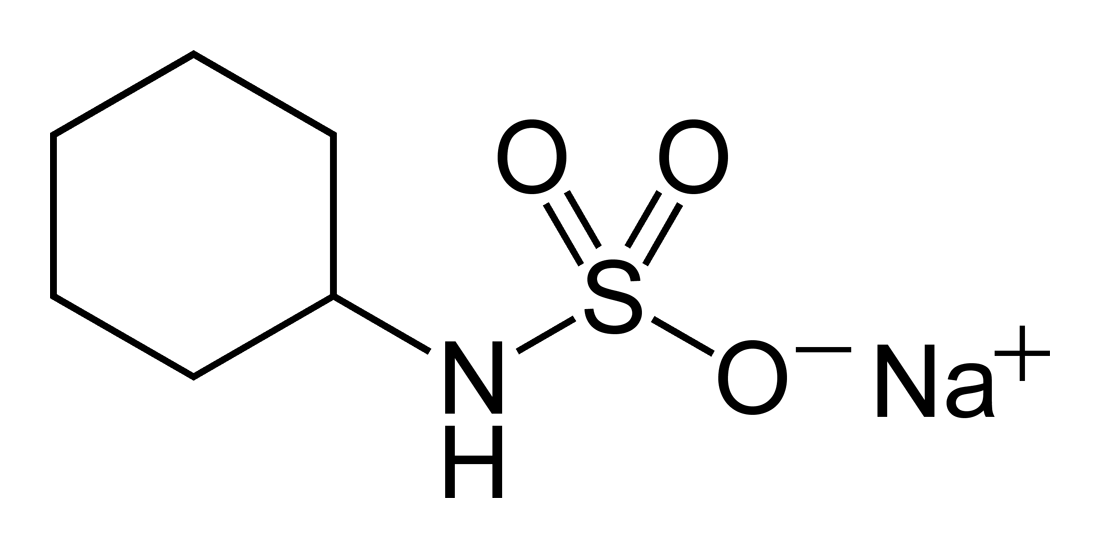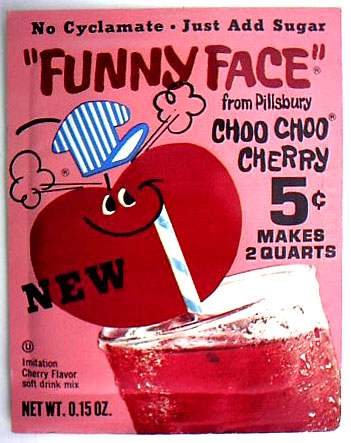Cyclamate
Editor-In-Chief: C. Michael Gibson, M.S., M.D. [1]
Cyclamate is an artificial sweetener that was discovered in 1937 at the University of Illinois by graduate student Michael Sveda.
Like many artificial sweeteners, the sweetness of cyclamate was discovered by accident. Michael Sveda was working in the lab on the synthesis of anti-fever medication. He put his cigarette down on the lab bench and when he put it back in his mouth he discovered the sweet taste of cyclamate. The patent for cyclamate was purchased by DuPont but later sold to Abbott Laboratories which undertook the necessary studies and submitted a New Drug Application in 1950. Abbott intended to use cyclamate to mask the bitterness of certain drugs such as antibiotics and pentobarbital. In the US in 1958 it was designated GRAS (Generally Recognized as Safe). Cyclamate was marketed in tablet form for use by diabetics as an alternative tabletop sweetener, as well as in a liquid form; one such product was named 'Sucaryl' and is still available in non-US markets.
Cyclamate is 30–50 times sweeter than sugar (depending on concentration; it is not a linear relationship), making it the least potent of the commercially used artificial sweeteners. Some people find it to have an unpleasant aftertaste, but generally less so than saccharin or acesulfame potassium. It is often used synergistically with other artificial sweeteners, especially saccharin; the mixture of 10 parts cyclamate to 1 part saccharin is common and masks the off-tastes of both sweeteners. It is less expensive than most sweeteners, including sucralose, and is stable under heating.
Chemistry

Cyclamate is the sodium or calcium salt of cyclamic acid (cyclohexanesulfamic acid). It is prepared by the sulfonation of cyclohexylamine; this can be accomplished by reacting cyclohexylamine with either sulfamic acid or sulfur trioxide.
Cancer

In 1966, a study reported that some intestinal bacteria could desulfonate cyclamate to produce cyclohexylamine, a compound suspected to have some chronic toxicity in animals. Further research resulted in a 1969 study which found the common 10:1 cyclamate:saccharin mixture to increase the incidence of bladder cancer in rats. The released study was showing that eight out of 240 rats fed a mixture of saccharin and cyclamates, at levels of humans ingesting 350 cans of diet soda per day, developed bladder tumors. Other studies implicated cyclohexylamine in testicular atrophy in mice. On October 18, 1969, the Food and Drug Administration citing the Delaney Amendment banned its sale in the United States and the United Kingdom followed suit the next year. Abbott Laboratories claimed that its own studies were unable to reproduce the 1969 study's results, and in 1973, Abbott petitioned the FDA to lift the ban on cyclamate. This petition was eventually denied in 1980 by FDA Commissioner Jere Goyan. Abbott Labs, together with the Calorie Control Council (a political lobby representing the diet foods industry), filed a second petition in 1982. Although the FDA has stated that a review of all available evidence does not implicate cyclamate as a carcinogen in mice or rats, cyclamate remains banned from food products in the United States. The petition is now held in abeyance (it is not actively being considered) though whether this is at the request of Abbott Labs themselves or because the petition is considered to be insufficient by the FDA is unclear. Cyclamate is approved as a sweetener in more than 55 countries: for example, the brand-name beverage sweetener Sweet'N Low, which contains only dextrose, saccharin, cream of tartar, and calcium silicate in the United States, contains cyclamate in Canada (where saccharin is banned except for diabetic usage). Similarly, Sugar Twin, the brand-name cyclamate sweetener in Canada, contains saccharin in the United States. (October 1969)
Male reproduction
One reported effect in animal studies (mice and primates) is irreversible testicular atrophy and an apparent impact on seminal vesicle function.
However, possible negative impacts on male reproductive ability and/or function may lie outside the remits of committees tasked to determine the safety of a product based only on its expected impact on life expectancy and/or cancer rates. Since a reduction in male testosterone levels is thought to be associated with a reduced incidence of certain cancers (such as testicular cancer), and an increased life expectancy, a substance that damages testosterone production may be easier to be classified as safe when life expectancy and carcinogenicity are the deciding criteria.
Since cyclamates appear to affect cells involved in the production of spermatozoa, the question has also been raised as to whether they may also be capable of damaging male reproductive DNA. There does not yet seem to be any direct evidence either for or against this.
Cyclamate Sweetener Brands
- Assugrin (Switzerland, Brazil)
- Sucaryl
- Sugar Twin (Canada)
External links
- http://www.rosalindfranklin.edu/cms/biochem/walters/sweet/cyclamate.html
- http://ec.europa.eu/food/fs/sc/scf/out53_en.pdf European Commission Revised Opinion On Cyclamic Acid
- http://www.cfsan.fda.gov/~dms/opa-abey.html US FDA Petitions Currently Held in Abeyance
- http://environmentalchemistry.com/yogi/chemicals/cn/Cyclohexanesulfamic%A0acid,%A0monosodium%A0salt.html List of other chemical and brand names for cyclamate
- http://www.hermesetas.com/data/en/specialised/sweeteners/history.php A brief history of sweeteners, including the discovery of cyclamate
- http://www.assugrin.ch/daten_f/maison.php Assugrin's website (French)
- http://www.foodcomm.org.uk/press_97_cyclams.htm concerns over potential "testicular wasting" in male users
Template:E number infobox 950-969
cs:Cyklamát da:Cyklamat de:Cyclamat eo:Ciklamato gl:Ciclamato nl:Cyclamaat no:Cyklamat fi:Syklamaatti sv:Natriumcyklamat